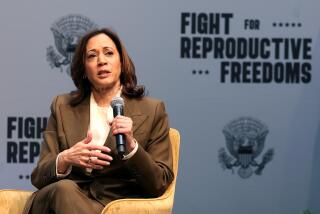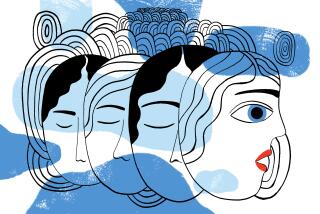The Abortion Case That Changed America : ROE V. WADE The Untold Story of the Landmark Supreme Court Decision That Made Abortion Legal <i> by Marian Faux (A Mentor Book/ New American Library: 4.95; 386 pp.)</i>
- Share via
The cross currents in the abortion issue are many. A highway sign on Route 99 in California’s Central Valley reads, if I remember, “The right to an abortion,” but the words an abortion are stricken and the word kill is interlineated. At the same time, in 1988, for the first time in a decade, the California Legislature did not include a budgetary prohibition on the use of public funds for abortion.
“Roe v. Wade,” the paperback edition of a book published a year ago by Macmillan, examines where this country has been on the issue of abortion. More than two decades ago, in “Gideon’s Trumpet,” Anthony Lewis wrote a moving account of the human experience and legal evolution of Gideon v. Wainwright, wherein the Supreme Court established the right of the poor to have a court-appointed lawyer. A decade ago, “Simple Justice” by Richard Kluger captured the times of Brown v. Board of Education, which ruled unconstitutional discrimination on the basis of color in education and, by implication, in all public life in America.
Marian Faux, in “Roe v. Wade,” speaks to the most important case affecting women’s rights ever decided by the high court. Its subtitle captures the content: “The Untold Story of the Landmark Supreme Court Decision That Made Abortion Legal.” The tale is told with a distinctly pro-choice tilt.
Several stories are effortlessly interwoven in the telling. Who was Roe and how did she become the person on whose behalf the court ruled? Roe is Norma McCorvey. When she became the plaintiff, she appeared to be a failure in life--no job, little education, failed marriage--yet, she persevered in Roe mostly for the benefit of others. Nobility can be found in all of us.
Who were Roe’s lawyers? Two young and inexperienced women accepted the case without a fee--Linda Coffee, age 26, and Sarah Weddington, age 23. They became lawyers to serve others. Seemingly without recognizing it, they became part of the growing women’s movement. Faux recounts their strategies, labors and frustrations in filing the action challenging the constitutionality of the Texas abortion statutes.
Who formed the extended family in this battle? There was the Dallas group--Ginny Whitebill and others--who struggled to liberalize abortion laws. They believed that the restrictions were morally wrong and discriminatory against the poor. Theirs was a selfless labor.
Another story is the history of abortion and the statutes that restricted it. Until the 19th Century, no laws prohibited abortion. For centuries, common law had assumed that abortion was a decision for the women. Abortion before “quickening,” the time when a woman first feels movement, had not been condemned in earlier times. We get a glimpse of how and why statutes prohibiting abortion became the rule this century.
These and other stories melt into the larger drama of the court opinion Roe v. Wade. The legal papers and procedures are explained, and, of course, the fascination of the “behind the bench” scene is captured for the reader. There is Chief Justice Burger, seemingly twisting internal procedures to assign the case; there is Justice Douglas, impatient to strike a clear blow for women; there is scholarly Brennan writing extensive memoranda; but most of all, there is Justice Blackmun, suffering over this extraordinarily complex and potentially disruptive opinion.
I was a professor teaching constitutional law at the University of New Mexico in Albuquerque when Roe v. Wade was filed. I recall no other case that so excited those about me, professors and students. I copied the various opinions, distributed them to my class and spent several class hours discussing their implications. Was the opinion truly a “privacy” case (the constitutional right of privacy articulated by the Supreme Court)? Was it a “substantive due process” case (the concept of fairness which the court had utilized earlier in the century to strike down economic legislation such as the minimum wage, but also used by the court to establish personal rights like that of procreation or the right to speak a language other than English)? Those and other theories debated in class find their way into the pages of this book.
Will Roe v. Wade be overturned? Supreme Court Justice Justice Harry Blackmun told University of Arkansas students that “there is a very distinct possibility that it will,” according to a report in the September 16, 1988 Christian Science Monitor. He added: “You can count the votes.”
The court is now poised to review the abortion case Webster (Atty. Gen. of Missouri) v. Reproductive Health Services. But however it decides, “Roe v. Wade” will remain an important contribution. Faux’s writing style is not as enthralling as that of “Gideon’s Trumpet” and “Simple Justice.” But that aside, her book captures a vital social issue during one capsule in time--when a case is decided--and places it effectively in its historical and legal context.
More to Read
Sign up for our Book Club newsletter
Get the latest news, events and more from the Los Angeles Times Book Club, and help us get L.A. reading and talking.
You may occasionally receive promotional content from the Los Angeles Times.






